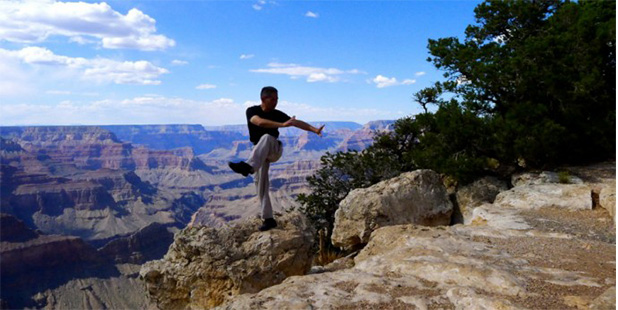Now that we understand what qigong and qi actually are (if you have not read part one, do so HERE), we can begin to explore the various applications and styles of qigong.
There are three primary reasons people practise qigong; medical, health, and to enhance martial arts training.
Medical qigong is one of the four main branches of Traditional Chinese Medicine (TCM) with the focus on the practitioner helping their patient to correct imbalances and energy blockages through regulation of their qi. This enables the body to strengthen and regulate the internal organs, the nervous system and the immune system, relieve pain, regulate hormones, and strengthen and release deep-seated emotions and stress. (Click here for more on medical qigong.)
Martial qigong was most likely developed after the monks of the Shaolin Temple began practising the early forms of qigong attributed to Bodhidharma (Da Mo), the Yi Jin Jing (Muscle Tendon Changing Classic) and Xi Sui Jing (Marrow Cleansing Classic), were developed. Through the practise of these qigong forms the monks found that not only could they improve their health, they could increase the power of their martial art techniques. Since the origination of these two early qigong forms, many martial arts styles have developed their own qigong sets and many martial styles have been developed on qigong theory. (Click here for more on medical and martial qigong.)
Using qigong as a form of exercise for health and longevity is probably the most popular of the applications of qigong. The coupling of slow movements matched to natural breathing patterns allows for the practitioner to become totally engaged in the present moment which makes qigong a sort of moving meditation. This allows qigong to become an excellent form of holistic exercise developing the mind, body, and spirit.
There are thousands of styles of qigong exercise practised worldwide. Some of the styles I have been exposed to or practised are:
- Zhan Zhuang Qigong
- Little Nine Heaven Qigong Form
- Chi Lel Qigong
- Lamas Qigong
- Dayan (Wild Goose) Qigong
- Tai Chi Qigong 13 Form
- Tai Chi Qigong Shibashi 18 Form
- Baduanjin (Eight Pieces of Brocade)
- Yi Jin Jing (Muscle Tendon Changing Classic)
- Xi Sui Jing (Marrow Cleansing Classic)
- Yi Jin Xi Sui Jing (Muscle Tendon Changing / Marrow Cleansing Classic)
- Tai Gong By The Sea
- Yin Yang Tai Gong
What is the right style for you? Choose what application you are most attracted to. If you are interested in martial arts or are currently practising a martial art and want to add qigong, find a martial arts teacher who teaches qigong. The Yi Jin Jing is a great addition to martial arts practice. If your interest is in medical qigong due to a chronic illness or disease, you will need to find a specialist in Traditional Chinese Medicine to help you. If you are strictly interested in improving your health, a simple qigong form such as the Baduanjin would be a good choice. Do some research and ask around. Try a few different teachers until you find one that resonates well with you.
Regardless of the style of qigong you select to practise, all qigong styles share three common attributes:
- Regulation of the posture of relaxation.
- Regulation of the mind.
- Regulation of the breathing.
Personally, to compliment my Yang and Chen style Taiji practice, I have to come to favor the Yi Jin Jing and Xi Sui Jing forms, as well as the Yi Jin Xi Sui Jing. I also find a lot of benefit in the Baduanjin and have learned a couple different ways to practise that form as well. I am very fortunate to have found a teacher of authentic Shaolin martial arts to learn from. My teacher (or Shifu), Shi Deru, is a 31st generation master from the Shaolin Temple in China and was a direct disciple of the last real spiritual Abbot of the temple, grandmaster Shi Suxi.
I think it is more important to find a form, learn to perform it well, and practise it consistently then to learn many different forms that you never master nor practise with any regularity.
“I fear not the man who has practiced 10,000 kicks once, but I fear the man who has practiced one kick 10,000 times.” – Bruce Lee
In part 3 of this blog series we will look at how to set up our qigong practice as well as other methods that enhance qigong.
In Health,
Scott






